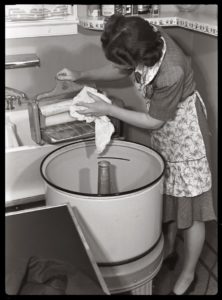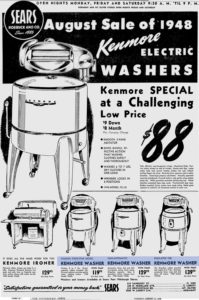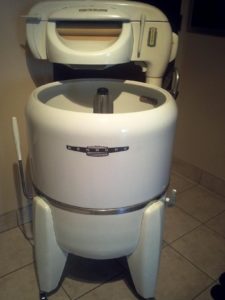
Today’s column will probably wake up a few long-dormant memory cells. In my case, it was my grandmother who had a wringer washer. But for many of you, it might have been dear old mom herself.
Keeping one’s clothes clean has been a challenge since clothing itself began being worn. The wealthy would have servants do their laundry, or perhaps would take it to a laundry business to be picked up later. The rest of society used rocks at the creek, or perhaps a tub and a washboard.
But in 1907, Maytag began marketing the Pastime. It was a hand-cranked washer, equipped with a flywheel to aid in the agitation of the clothes, which featured a wringer at the top so that the wash water could be extracted before the clothes were fed into a rinsing tub.
The wringer washer was high-tech stuff. No more endless hand-wringing of clothes! How much easier could life get?

Today, of course, wringer washers are largely unseen outside of antique shops. But it turns out that our grandmothers were actually green advocates before there even was such a movement. That’s because wringer washers use a fraction of the water and electricity (or gasoline, in some cases) that modern multi-cycle washers do.
You see, grandma would fill the washer with water and finely-shaved Fels Naphtha soap, them agitate the mixture so the soap would dissolve. Then, she would put the whites in and agitate for ten minutes or so. If the home had electricity, the more well-to-do would have an electric motor to do the job. Out in the country, a gasoline motor did the work. Of course, the less affluent turned a crank on the side.
Once the whites were done, they were wrung out and dropped into the bluing tub. The bluing made them look whiter. Then, another wringing and into the rinse tub.
In the meantime, the lighter colored clothes were being agitated in the same water the whites used! And when they were done, the darker colors went in. That’s three loads of clothing for the price of one load of soap and water!
The rinse water too was reused. So a family’s entire week’s worth of clothes could be laundered with the amount of water used to handle a single load in a modern washer.
No wonder some of our thrifty parents and grandparents were reluctant to give up their wringer washers.

By the 1960’s, few homemakers still used wringers. But it seemed that many of them couldn’t bear to throw away the reliable, economical devices either. Hence, the one I played with at my grandmother’s house in Mason, Texas. And many of my friends had wringer washers stashed in outbuildings, garages, and sometimes sitting outside.
They were fun for a kid to play with, too, although you didn’t want to get an arm caught in the rollers or you would get one ugly blister.
In researching this piece, I found a website (lehmans.com) that will sell you a Saudi Arabian made brand new wringer washer for about 900 bucks. It’s an exact remake of the classic Speed Queen. They also sell reconditioned Maytags with electric or gasoline engines!
So Boomers, if you really want to go green, follow the example of your grandmother. And you’ll have it much easier, too. Just pour in some liquid detergent. You won’t have to shave that Fels Naphtha soap anymore!
Growing up on my grandparents’ farm, that was all we used. The two galvanized steel rinse tubs were positioned at an “L” to the washer so the clothes were run through the wringer from wash to Tub 1, then the wringer was unlocked / pivoted 90 degrees clockwise / locked so clothes went through the wringer again from Tub 1 to Tub 2. The whole mess drained into a drain in the basement floor. THEN the wet clothes were hung on the line to dry… no gas or electric tumble dryer for us!